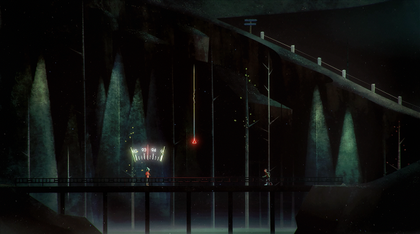Trending
Opinion: How will Project 2025 impact game developers?
The Heritage Foundation's manifesto for the possible next administration could do great harm to many, including large portions of the game development community.
Oxenfree's watercolor art style has earned it a nomination for the IGF Award in Excellence in Visual Art. Lead designer Sean Krankel explains how its visual design impacted gameplay.

This interview is part of our Road to the IGF series. You can find the rest by clicking here.
Choice-driven gameplay in modern adventure games often comes down to asking players to make sweeping, dramatic choices in the face of epic conflicts. Night School Studio's Oxenfree, however, has earned praise and sparked discussion by telling the small story of a group of teens stranded on a haunted island. Its heroine, a high-school senior named Alex, spends most of her time mulling over the mundanities of teenage woes while trying to survive the strange ghosts of an abandoned military base.
Oxenfree's watercolor-inspired art style has earned it a nomination for the IGF Award in Excellence in Visual Art. Speaking to Gamasutray by e-mail, lead designer Sean Krankel explained the origins of Oxenfree, and how its visual design wound up impacting gameplay.
Krankel: I've had a pretty varied go of it, both in design and production roles over the years. I started as an associate producer at Universal Interactive after leaving the film world, eventually making my way into design on some of the later Crash Bandicoot games. I left games proper for a couple years, working as a creative director in the advertising world for games and film, including writing and designing an ARG for the Focus Features film "9". I spent a few years at Disney Interactive working on a variety of games, most recently as design director on the "Where's My Water?" franchise.

Krankel: The team primarily used Unity, Photoshop and Maya to build the majority of the game.
Krankel: Oxenfree was in production for a little over a year, but my co-founder Adam and I had the idea for the game's world and core mechanics bouncing around in our heads for a few months prior.
Krankel: Initially we took a look at other games and studios that placed a premium on storytelling, and wanted to uncover one or two key areas that we hoped we could improve on how those games were handling story progression. On one end of the spectrum you had these extraordinary set-piece based action adventures with linear stories, and on the other end you had choice-based, cut-scene focused branching narratives. We thought, why not let you move freely while communicating, interacting, and exploring a branching narrative? That led us to the core mechanics concept. Simultaneously we were talking about film genres that were meaningful to us, and coming of age tales kept surfacing in our discussions. Ultimately we landed on a spooky coming of age tale while we were prototyping the basic moveset.

Krankel: We don't discriminate when it comes to stories that excite us creatively, meaning games, film, books, and TV worlds were all meaningful wells of inspiration. The lead character from "Freaks and Geeks", Lindsay Weir, was probably the biggest external influence on Oxenfree, and our lead character Alex shares some of her qualities as a teen testing her boundaries on the verge of becoming an adult.
The rest of the cast are intended to challenge and play off various aspects of Alex as a character and the player's real-life perspective. Jonas, Alex's new step-brother, is as much a stranger to Alex as he is to the player. Ren is Alex's oldest friend, but kind of an embarrassing jackass. Clarissa is the closest thing to a human antagonist in the game, and her dark history with Alex surfaces as the game's events become more frightening. All of these characters initially provide a palette for the player's own personality to bounce off, and later become fodder for the ghostly creatures in the game to manipulate and subvert player expectations.
Krankel: Oxenfree's art style evolved throughout pre-production to match the game's design and story needs. Initially, we challenged our lead artist Heather Gross to accommodate multiple characters, dialogue bubbles, and exploration-friendly environments before the game's story arc had crystallized. So the camera distance and 2D approach were purely decisions of function. As we evolved the story, characters, and world of the game, Heather's style became more cinematic... almost like parallaxing feature animation matte paintings, to feel more like a dark animated film. I really can't give her enough credit; the look and feel of the game are all Heather! She had her work cut out for her, as most of the game takes place at night, but she found a way to make the world feel organic and inviting. The supernatural elements, by contrast, were meant to feel bright,geometric, and otherworldly, so that they felt extremely foreign in the otherwise lush island.
The radio system covers a broad range of sound design, from historical insight to creepy remixed noises.
Krankel: SCNTFC (Andy Rohrmann) was our musician and sound designer, and worked hard to merge our visual style with his creations. The score and sound effects of Oxenfree are intended to feel analog and digital at the same time, if that makes sense, so that it's nostalgic without being set in a specific time in the past. Andy accomplished this through the use of as many analog recording techniques as possible, and many times degrading or flat out physically breaking down the actual recordings to feel warbly and grimy, even when it's beautiful and melodic. In the end, we hope the game itself feels haunted!
Krankel: Her Story is brilliant, we wish we made it. I wish Super Hot could win everything! Such a great design.
Don't forget check out the rest of our Road to the IGF series right here.
You May Also Like